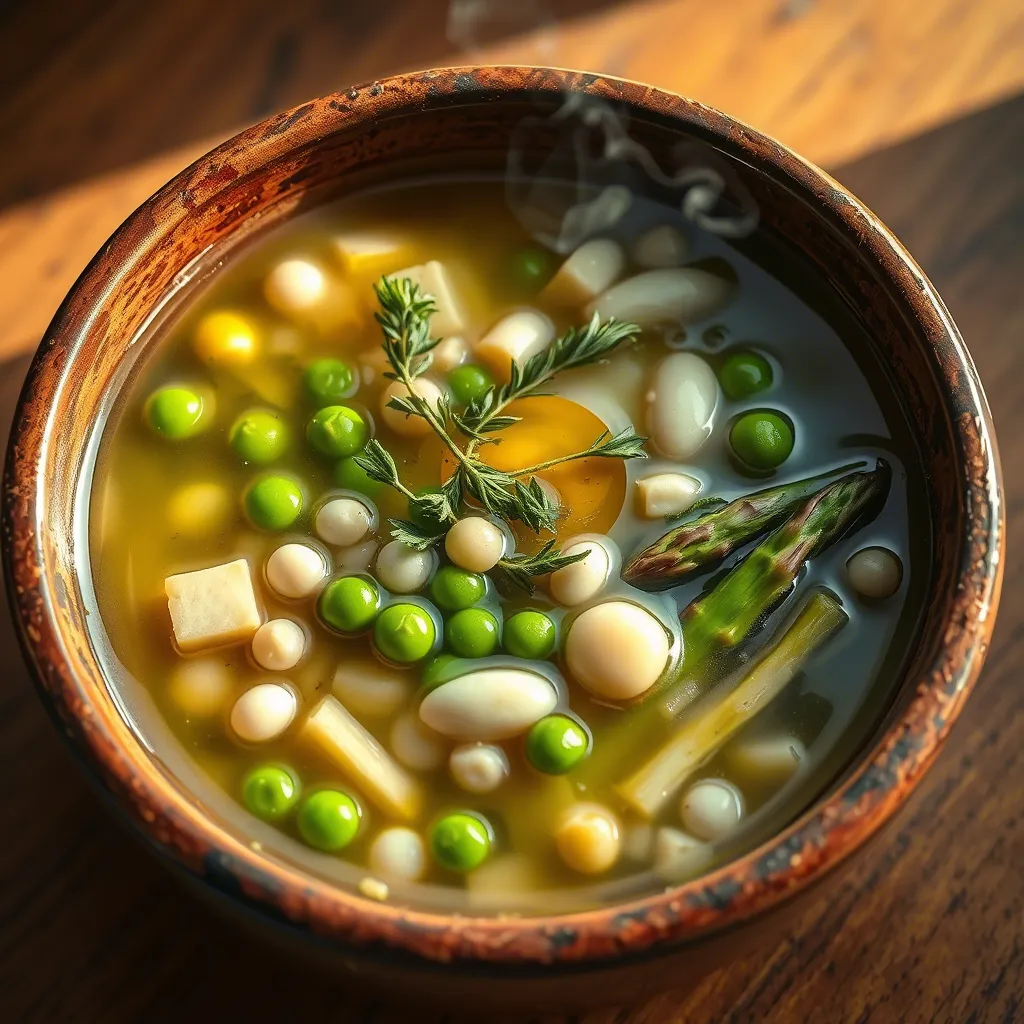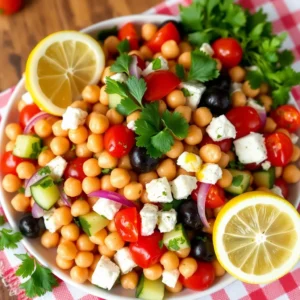Why You’ll Love This Spring Minestrone
Hello, lovely readers! Alexandre here, ready to brighten your day with a bowl of sunshine that we call Spring Minestrone with Fresh Herbs. There’s something magical about the first spring vegetables appearing at the farmer’s market – those tender green peas, young asparagus spears, and fresh herbs that seem to whisper, “Winter is finally over!” This spring soup is my celebration of those first green shoots of the season.
As a busy parent myself, I understand the daily dinner dilemma all too well. You want something nutritious and delicious, but who has hours to spend in the kitchen after a long day? That’s exactly why this vegetable minestrone will become your new weeknight hero. Unlike those heavy winter stews that simmer for hours, this spring version comes together in under an hour, with most of that time being hands-off simmering – giving you precious minutes to help with homework, fold that stubborn laundry pile, or simply put your feet up with a well-deserved cup of tea.
What makes this minestrone truly special is its incredible versatility. Got some slightly wilted spinach in the crisper drawer? Toss it in! Only have frozen peas instead of fresh? Works perfectly! This soup forgives substitutions and even welcomes them with open arms. It’s the Swiss Army knife of weeknight dinners – adaptable, reliable, and always there when you need it.
The broth alone is worth writing home about – light yet satisfying, herby without being overpowering, and somehow managing to taste like spring sunshine in liquid form. It’s the kind of soup that makes everyone at the table pause after the first spoonful and say, “Wow, what’s in this?” (Don’t worry, I’ll share all my secrets!)
For my busy mom friends trying to sneak more vegetables into resistant little eaters – this soup has been kid-tested and approved by my own picky brigade. There’s something about the colorful confetti of vegetables and the tiny pasta shapes that makes even vegetable skeptics willing to give it a try. As my daughter Sophia says, “It’s like eating a garden, but in a good way!” High praise from an 8-year-old who normally considers peas her mortal enemies.
And for those of you counting calories or following specific eating plans – this spring vegetable minestrone is naturally light, packed with nutrients, and can easily be made gluten-free, dairy-free, or vegan with a few simple swaps I’ll share later. It’s the rare recipe that feels both comforting and light at the same time.
The Story Behind This Spring Minestrone
My journey with this particular herb soup began, like many great kitchen adventures, with an abundance problem. Three springs ago, I had enthusiastically over-planted my herb garden. If you’ve ever grown basil or parsley, you know how quickly they can go from “barely sprouting” to “taking over the world.” One Saturday morning, staring at enough herbs to open my own small produce stand, I knew I needed to find a solution beyond the usual pesto or tabbouleh.
That same day, my mother-in-law called with her usual perfect timing. She was driving through town on her way to visit cousins and wanted to stop for lunch. Now, my mother-in-law is the kind of spectacular Italian home cook who can tell if you’ve skimped on the good olive oil just by smelling a dish from across the room. No pressure, right?
With a fridge full of spring vegetables from my weekly CSA box and that jungle of herbs threatening to stage a coup in the garden, I decided to make what my grandmother would call “la cucina povera” – the cooking of humble ingredients transformed through a little love and attention.
The resulting soup was a revelation. My mother-in-law not only asked for a second bowl (the highest compliment) but also insisted I write down exactly what I’d done. “This reminds me of my childhood in Naples,” she said, “but lighter, more… springlike.” Coming from her, this was essentially a Michelin star.
What I love most about this recipe is how it connects generations. There’s something deeply satisfying about taking a traditional Italian minestrone – a soup that countless grandmothers have made to stretch ingredients and feed families – and giving it a fresh, seasonal twist. The bones of the recipe honor tradition, while the spring vegetables and abundant herbs bring it firmly into the present.
Since that fortunate garden overflow, this Spring Minestrone with Fresh Herbs has become our traditional welcome-to-spring meal. When we can finally eat dinner on the patio again, this soup is invariably what’s steaming in our bowls. My children now help harvest the herbs, learning the difference between basil and mint, parsley and cilantro, by smell and touch before they’re tall enough to read the plant markers.
This soup has also saved countless weeknight dinners when I’ve stared blankly into the refrigerator at 5:30 pm, wondering what on earth to make. As long as you have some broth, a handful of vegetables, and a few fresh herbs, you can create something that tastes intentional rather than desperate. And isn’t that the secret to successful home cooking? Making “whatever we have” taste like “exactly what we wanted.”
For more amazing one-pot wonders that will save your weeknights, check out my 10 Amazingly Easy Frittata Recipes: Your Ultimate One-Pan Wonder for Breakfast, Lunch, or Dinner – another versatile recipe that comes to the rescue when time is tight but you still want something homemade and delicious.
So let’s gather our ingredients and welcome spring the best way I know how – with a steaming bowl of minestrone that captures the season in every spoonful.
Ingredients
Let’s talk about what makes this Spring Minestrone with Fresh Herbs sing with flavor. The beauty of this vegetable minestrone is that while I’ll give you my favorite combination, you can adapt based on what looks freshest at your market or what’s already lurking in your vegetable drawer.
For the base of our spring soup, you’ll need:
- 2 tablespoons extra virgin olive oil (please use the good stuff here – it makes a difference!)
- 1 medium yellow onion, diced (about 1 cup)
- 2 medium carrots, diced (about ¾ cup)
- 2 celery stalks, diced (about ½ cup)
- 3 cloves garlic, minced
- 6 cups vegetable or chicken broth (homemade is wonderful, but a good quality store-bought works beautifully too)
- 1 can (14.5 oz) diced tomatoes with their juices
- 1 Parmesan rind (optional, but adds amazing depth – I keep these in my freezer just for soups)
- 1 bay leaf
- ½ teaspoon red pepper flakes (adjust to your heat preference)
- Salt and freshly ground black pepper to taste
Now for the spring stars of our show:
- 1 cup fresh or frozen peas
- 1 small zucchini, diced (about 1 cup)
- 8 asparagus spears, woody ends removed, cut into 1-inch pieces
- 2 cups baby spinach or tender spring greens
- ½ cup small pasta (like ditalini, orzo, or small shells)
And for that fresh herb finish that makes this soup special:
- ¼ cup fresh basil leaves, torn or thinly sliced
- 2 tablespoons fresh parsley, chopped
- 2 tablespoons fresh chives, snipped
- 1 tablespoon fresh mint leaves, torn (trust me on this one!)
- 1 tablespoon fresh lemon juice
- Grated Parmesan cheese for serving
Let’s talk about some of these ingredients in more detail. The traditional Italian soffritto (onion, carrot, and celery) creates a flavor foundation that’s stood the test of time. Think of it as the backup singers that make the lead vocalists shine. Don’t rush this step – allowing these vegetables to soften slowly develops sweet, complex flavors that define good soup.
For the broth, I prefer using vegetable broth in spring for its lighter flavor that lets the vegetables shine. But chicken broth works beautifully too, adding a bit more body and richness. If you’re watching sodium, use low-sodium broth and adjust the salt at the end.
That Parmesan rind might seem like an odd addition, but it’s my secret weapon in soups. As it simmers, it slowly melts, releasing umami goodness and a subtle creaminess without adding any actual cream. If you buy wedges of Parmesan, save those rinds in your freezer – they’re kitchen gold!
Regarding the pasta, smaller is better here. You want the pasta to be a team player, not the star. Ditalini, orzo, or small shells are perfect because they’re substantial enough to hold their own but small enough to fit comfortably on a spoon with the vegetables. If you’re making this ahead of time or expect leftovers, consider cooking the pasta separately and adding it to individual bowls when serving to prevent it from absorbing too much broth and becoming mushy.
For those avoiding gluten, simply swap in your favorite gluten-free pasta or omit it entirely – the soup is still wonderful without it. You could also substitute cooked quinoa or rice.
Fresh herbs are non-negotiable in this recipe (it’s in the name, after all!). Each herb brings something special: basil offers sweet, aromatic notes; parsley adds bright freshness; chives contribute a gentle onion flavor; and mint brings an unexpected cooling quality that works magic with the sweet spring vegetables. If you don’t have all four, don’t panic – even just basil and parsley will create a lovely result.
Execution
Now that we’ve gathered our ingredients, let’s bring this Spring Minestrone with Fresh Herbs to life. The process is straightforward, but I’ll share some visual cues to help you nail each step.
- Prepare the soffritto: In a large Dutch oven or heavy-bottomed pot, heat the olive oil over medium heat until it shimmers slightly. Add the diced onion, carrot, and celery along with a pinch of salt (which helps draw out moisture). Sauté for 5-7 minutes until the vegetables have softened but not browned. They should look glossy and the onions should be translucent. This is not the time to practice your high-heat wok skills – gentle heat coaxes out the sweetness.
- Add aromatics: Stir in the minced garlic and red pepper flakes, cooking for about 30 seconds until fragrant. You’ll know it’s ready when the garlic aroma makes your mouth water but hasn’t taken on any color. Garlic turns bitter when browned, so keep a close eye on it!
- Build the broth base: Pour in the broth and add the diced tomatoes with their juices. Drop in the bay leaf and Parmesan rind if using. Season with a few grinds of black pepper – you can always add more salt later.
- Bring to a simmer: Increase the heat to high just until the soup comes to a boil, then immediately reduce to maintain a gentle simmer. You want to see small bubbles breaking the surface, not a rolling boil. Cover partially with a lid and let simmer for about 15 minutes to allow the flavors to meld.
- Cook the pasta: Add the small pasta to the simmering broth. Cook according to the package directions minus 2 minutes (it will continue cooking in the hot soup). For most small pasta shapes, this is about 6-8 minutes of simmering. Stir occasionally to prevent sticking.
- Add the spring vegetables: When the pasta is almost al dente, add the diced zucchini and asparagus pieces. Simmer for 2 minutes, then add the peas and cook for 1 minute more. The goal is to cook each vegetable just until tender-crisp – we want vibrant green colors, not army green mushiness!
- Finish with greens and herbs: Turn off the heat and stir in the baby spinach or spring greens, allowing them to wilt from the residual heat. Add the lemon juice and fresh herbs, stirring gently to incorporate. The aroma that rises up at this point is spring in a pot!
- Taste and adjust: Remove the bay leaf and Parmesan rind. Taste the soup and adjust the seasoning with additional salt, pepper, or a splash more lemon juice as needed. The soup should taste bright and well-seasoned but not salty.
- Serve with love: Ladle the hot soup into bowls, top with a sprinkle of grated Parmesan cheese and, if you’re feeling fancy, a few additional herb leaves. A drizzle of your best olive oil on top takes this from delicious to restaurant-worthy.
The entire cooking process should take about 30 minutes of active time, with the soup ready to eat in about 50 minutes total. If you’re making this on a busy weeknight, you can chop all the vegetables and measure ingredients in the morning or even the night before.
For an expert take on traditional Italian soups that inspired this spring version, check out Serious Eats’ guide to Italian soups. They dive deep into the regional variations that have influenced my own cooking journey.
If you’ve been wanting to try your hand at making homemade pasta to use in this soup, my Incredibly Easy Homemade Potato Gnocchi: 4 Simple Steps to Perfect Italian Dumplings provides a wonderful alternative that pairs beautifully with this broth.
Remember, soup making is more art than science. If your diced vegetables aren’t perfectly uniform, or if you simmer a minute too long – it’s all good! As my grandmother used to say, “Soup tastes better when made with love than when made with precision.” Those little imperfections are what make homemade soup so much more satisfying than anything from a can.
Additional Tips
Let’s take your Spring Minestrone with Fresh Herbs from delicious to absolutely unforgettable with these extra tips and variations that I’ve gathered over years of soup-making adventures.
Storage and Make-Ahead Magic: This spring soup actually improves with time as the flavors meld together. You can store it in an airtight container in the refrigerator for up to 5 days. The pasta will continue to absorb broth as it sits, so when reheating, you may need to add a splash of water or additional broth to bring it back to your desired consistency. For meal prep champions, you can make the soup through step 4 (before adding pasta and spring vegetables), refrigerate for up to 3 days, then finish with the remaining steps just before serving.
Freezer-Friendly Approach: If you want to freeze portions of this vegetable minestrone (and I highly recommend having some on hand for busy days), freeze it without the pasta and delicate herbs. When you’re ready to enjoy, thaw overnight in the refrigerator, heat until simmering, add fresh pasta to cook directly in the broth, and finish with fresh herbs. Properly stored, the soup base freezes beautifully for up to 3 months.
Wonderful Variations: Spring produce varies depending on your location and the exact timing of the season. Here are some wonderful swaps that work beautifully:
- Replace asparagus with tender green beans or sugar snap peas
- Swap zucchini for yellow summer squash or tender young fennel
- Use fava beans or lima beans instead of green peas
- Try different tender greens like arugula, watercress, or even dandelion greens for a pleasant bitter note
- For a protein boost, add a can of rinsed cannellini beans or 2 cups of shredded rotisserie chicken
Serving Suggestions: While this soup is a complete meal on its own, it pairs wonderfully with a crusty whole grain bread for dipping or a simple side salad dressed with lemon and olive oil. For appetizer portions, serve in small cups as the first course of a spring dinner party.
Thickening Options: If you prefer a heartier texture, you can use an immersion blender to partially blend some of the vegetables before adding the pasta and fresh spring vegetables. This creates a thicker base while maintaining plenty of chunky texture.
Dairy-Free and Vegan Adaptations: Simply omit the Parmesan rind and grated cheese on top. For added richness without dairy, finish each bowl with a drizzle of the best extra-virgin olive oil you have, or even a small dollop of dairy-free pesto.
Flavor Boosters: For an extra layer of flavor, consider adding a splash of white wine after cooking the aromatic vegetables and before adding the broth. Allow it to reduce for 1-2 minutes, which concentrates the flavor and cooks off the alcohol while adding pleasant acidity.
Herb Combinations: Don’t feel limited to the herbs listed in the recipe. Other fantastic additions include fresh dill (particularly nice with peas), tarragon (lovely with asparagus), or even a small amount of fresh thyme. Just remember that dried herbs won’t give you the same bright, spring-like flavor that makes this soup special.
Troubleshooting: If your soup tastes a bit flat, it usually needs one of three things: more salt, more acid, or more fat. Try adding a pinch of salt, a squeeze of lemon, or a drizzle of olive oil – often just one of these will bring everything into balance. Remember that proper seasoning makes the difference between good soup and great soup.
Equipment Notes: While any large pot will work, I prefer making this in a wide Dutch oven which allows the vegetables to cook more evenly without being crowded. If using a deeper pot, you might need to increase cooking times slightly.
For those interested in exploring more about the therapeutic aspects of cooking with fresh herbs, check out The Spruce Eats’ comprehensive guide to cooking with fresh herbs, which offers wonderful insights into herb combinations and preservation methods.
FAQs
Can I make this Spring Minestrone with frozen vegetables? Absolutely! While fresh spring vegetables provide optimal flavor and texture, frozen peas, green beans, and even asparagus work wonderfully in this herb soup. The only vegetables I wouldn’t substitute with frozen versions are the base aromatic ones (onion, carrot, celery) and the zucchini, which tends to become mushy when frozen and thawed.
How can I make this soup more substantial for hungry family members? This is easily solved by either increasing the amount of pasta (up to 1 cup) or adding protein. Cannellini beans, chickpeas, or shredded chicken are all excellent additions. You can also serve it with a heartier side like my 10 Steps to Irresistible Chicken Parmesan: The Ultimate Italian Comfort Food for Busy Weeknights for a complete meal that will satisfy even teenage appetites.
Can I use dried herbs instead of fresh? While you technically can substitute dried herbs, I strongly recommend using fresh for this particular recipe. The bright, vibrant flavor of fresh herbs is what transforms this from a standard vegetable soup into a spring celebration. If you absolutely must use dried, use them in much smaller quantities (about 1/3 of the fresh amount) and add them earlier in the cooking process, along with the broth.
My child doesn’t like “green things” in soup. Any suggestions? I’ve been there! Try pureeing the herbs with a little olive oil and stir this into the broth – you’ll get all the flavor without the visible “suspicious green bits.” Alternatively, you can strain the soup for picky eaters, reserving the vegetables and serving just the flavorful broth with pasta. Often, once they enjoy the taste, they become more open to trying the full version.
How can I make this soup even more budget-friendly? Focus on what’s most affordable in your area. Use frozen peas instead of fresh asparagus, skip the zucchini if it’s not in season locally, and utilize whatever herbs are growing in your garden or available inexpensively. The beauty of minestrone is its flexibility – it was originally designed as a frugal dish to use whatever vegetables were available. The Parmesan rind adds wonderful flavor but is completely optional.
Is this soup suitable for meal prepping? It’s perfect for meal prep! As mentioned in the storage tips, you can either prepare the entire soup and portion it for quick meals throughout the week, or prepare just the base and add the fresh elements when reheating. If you’re planning on eating it over several days, consider cooking the pasta separately and adding it to individual portions to prevent it from absorbing too much broth.
Can I make this in a slow cooker or Instant Pot? Yes to both! For slow cooker: Sauté the aromatics as directed, then transfer to the slow cooker with broth, tomatoes, and seasonings. Cook on low for 4-6 hours, then add pasta and vegetables during the last 30 minutes. For Instant Pot: Use the sauté function for the aromatics, add broth and seasonings, then pressure cook on high for 5 minutes. Quick-release pressure, add pasta and hearty vegetables, and use the sauté function to simmer until pasta is tender. Add delicate greens and herbs at the end.
Spring has always been my favorite season for cooking – that magical time when we transition from the heavy comfort foods of winter to the lighter, brighter flavors that match lengthening days and warming temperatures. This Spring Minestrone with Fresh Herbs captures that transition perfectly: it has the comforting quality of soup while celebrating the vibrant new produce of the season.
I hope this spring soup becomes a tradition in your home as it has in mine – a delicious marker of seasons changing and new beginnings. There’s something deeply satisfying about cooking with the rhythm of the seasons, connecting us to the earth and to generations of cooks who came before us.
Remember that the beauty of any minestrone lies in its adaptability. Make this recipe your own – adjust the vegetables based on what looks best at your market, experiment with different herb combinations, or add your family’s favorite protein. The only rule is that there are no rules, except to cook with love and enjoy every spoonful of this vegetable minestrone with those you care about.
As the days grow warmer, you might also enjoy my 10 Incredible Cucumber Tomato Salad Secrets: The Ultimate 15-Minute Refreshing Side Dish as another celebration of fresh, seasonal produce.
Happy spring cooking, friends!



